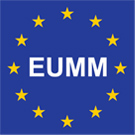In order to give you an insight in EUMM’s daily work, the Press and Public Information Office accompanied a team of German and Italian monitors from EUMM field office in Zugdidi. The field office’s area of responsibility covers the whole administrative boundary line with Abkhazia but also goes further south – to Poti, Senaki and Batumi. Our patrol took us up to the administrative boundary line with Abkhazia – from the Enguri dam to the Black Sea coast.
Being out in the field with EUMM monitors was quite an experience. We discovered the wonderful landscape of the Samegrelo region with its typical Caucasian mountain villages characteristic for Western Georgia. And then of course the Enguri dam – impressive! Near the dam there is Ivari village, where half-ruined houses look deserted.
Following the administrative boundary line along the Enguri river towards the Black Sea, we reached our first checkpoint. Before that, we were asked to put on our bullet-proof vests like all EUMM monitors. Although we are an unarmed civilian mission, we need to protect our monitors who patrol along the administrative boundary lines. There they constantly meet with armed personnel on both sides that is not always well-disposed towards EUMM and other international organisations. The same week, an OSCE patrol got under fire near the South Ossetian administrative boundary line.
We reached our first checkpoint at the Black Sea coast, at Ganmukhuri, we could see the Russian checkpoint as tiny dot.
Unfortunately, EUMM monitors are not yet allowed on the other side of the administrative boundary line. Thus, EUMM cannot get first hand information on what is going on there or monitor alleged incidents. But EUMM continues to “knock at the doors”. And the patrols speak to local population crossing the administrative boundary line.
One point, where local population can actually cross the administrative boundary line is the Rukhi bridge. It’s the only access to Gali district. Most people we spoke to during our patrol conveyed the feeling there were no real problems occur at the checkpoint. However, the monitors on other occasion had received the information of some violations of the freedom of movement. So e.g. some people reported that Russian passports were needed in order to cross Rukhi bridge or that they had to pay money.
In the end, our patrolling day was quiet and peaceful and we enjoyed the sunny weather and the beautiful landscape. However, the region only looks peaceful on the surface: there are still too many checkpoints, police forces, soldiers or militia and poverty. Looking into EUMM’s mandate, we must say that stabilisation and normalisation in this region has not yet been reached.
Being out in the field with EUMM monitors was quite an experience. We discovered the wonderful landscape of the Samegrelo region with its typical Caucasian mountain villages characteristic for Western Georgia. And then of course the Enguri dam – impressive! Near the dam there is Ivari village, where half-ruined houses look deserted.
Following the administrative boundary line along the Enguri river towards the Black Sea, we reached our first checkpoint. Before that, we were asked to put on our bullet-proof vests like all EUMM monitors. Although we are an unarmed civilian mission, we need to protect our monitors who patrol along the administrative boundary lines. There they constantly meet with armed personnel on both sides that is not always well-disposed towards EUMM and other international organisations. The same week, an OSCE patrol got under fire near the South Ossetian administrative boundary line.
We reached our first checkpoint at the Black Sea coast, at Ganmukhuri, we could see the Russian checkpoint as tiny dot.
Unfortunately, EUMM monitors are not yet allowed on the other side of the administrative boundary line. Thus, EUMM cannot get first hand information on what is going on there or monitor alleged incidents. But EUMM continues to “knock at the doors”. And the patrols speak to local population crossing the administrative boundary line.
One point, where local population can actually cross the administrative boundary line is the Rukhi bridge. It’s the only access to Gali district. Most people we spoke to during our patrol conveyed the feeling there were no real problems occur at the checkpoint. However, the monitors on other occasion had received the information of some violations of the freedom of movement. So e.g. some people reported that Russian passports were needed in order to cross Rukhi bridge or that they had to pay money.
In the end, our patrolling day was quiet and peaceful and we enjoyed the sunny weather and the beautiful landscape. However, the region only looks peaceful on the surface: there are still too many checkpoints, police forces, soldiers or militia and poverty. Looking into EUMM’s mandate, we must say that stabilisation and normalisation in this region has not yet been reached.
 |
 |
 |
 |
 |
|
|
|
